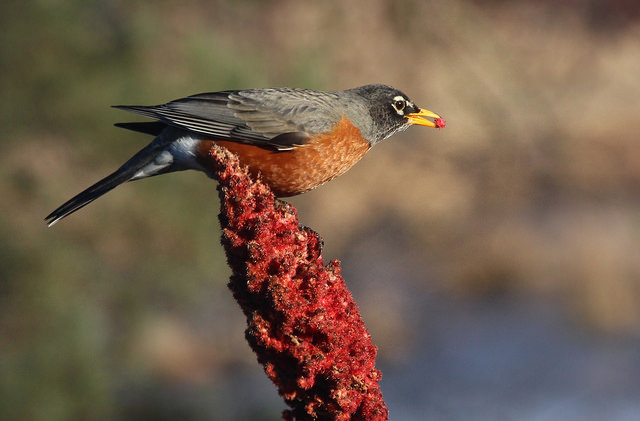It is late fall and Audubon’s bird feeders are starting to see the more activity. Resident birds such as Blue Jays, Northern Cardinals and Black-capped Chickadees are mapping out their winter food locations. Their bright colors a joyous contrast to the drab landscape. Evening Grosbeaks and Pine Siskins have been reported at local feeders this year. These irregular, unpredictable migrants may show up one winter and not the next. Late fall can be a wonderful, surprising time to be a bird watcher at the feeders.
But where do birds find their food if humans don’t feed them? Birdfeeders provide supplemental food. Birds find most of their food from wild plants and animals. When I scan my surroundings for fall and winter bird food, I have to look no farther than outside my office window.

Red Squirrel at the Staghorn Sumac. Photo by Jeff Tome
A large Staghorn Sumac (Rhus typhina) takes up a third of the view outside my window. The tree stands about 25 – 30 feet tall. On this late November day, its compound leaves have already fallen to the ground. This year’s growth is still covered in soft fuzz, much like the velvet covering of male deer (stag) antlers. Standing erect at the end of the branches are the clusters of fuzzy, red berries.
Was this sumac the result of an errant seed or was it planted with intention in a garden intended to provide food and shelter for birds? Either way, it serves its purpose quite nicely. For two months, I’ve keep track of all the birds I’ve seen on this sumac which is part of the bird garden at the Nature Center. Some birds just seem to be passing through, resting on the branches. I’ve witnessed House Sparrows, Goldfinches, Cedar Waxwings, and Eastern Bluebirds perched on the sumac outside my window.
Staghorn Sumac is on lists of native, bird-friendly plants mainly because of the clusters of red, fuzzy berries that form in the summer and remain through the winter. In glimpses in between work, I’ve witnessed Blue Jays, Red-winged Blackbirds, American Robins, Catbirds, European Starlings, Northern Flickers, and Downy Woodpeckers eating from the red berry clusters.
My observations are not quite complete. I wonder if some of those birds above are eating not the red berries but insects sheltering inside the tight clusters of berries. And my list includes more than birds. On several occasions, I’ve watched a Red Squirrel scurry up the tree to nip off the buds of next year’s growth.
This sumac is not a typical garden plant. It is most often seen in uncultivated places such as the edge of a field or the side of a road. In those well-drained, sunny places sumac thrives. A seed can be dropped and left to grow into a small tree. And then that tree can be left to spread through underground suckers into a small thicket.
Aside from being a “wild weed” sumac gets a bad rap because of the similarly named but unrelated Poison Sumac. However, it doesn’t take a keen observer to notice the differences between the two plants. Poison Sumac (Toxicodendron vernix) leaves and branches are smooth, not fuzzy and the berries white, not red. This uncommon shrub is more closely-related to Poison Ivy with the same rash causing oil in all its parts. Staghorn Sumac is quiet safe to humans as well as birds. In fact, the berries can be gathered and soaked in cold water to make a sour-flavored beverage. If the tiny hairs are strained and the dirty-dishwater color ignored the beverage is quite refreshing.

On this rainy, November day, I’ve added White-breasted Nuthatch to the list of birds perched in the tree but not eating. And the Downy Woodpecker that visited drank from the raindrops clinging to the fuzzy bark. I recall the brilliant orange-red leaves that glowed earlier this fall. I look forward to who else will visit the red berries as snow blankets our surroundings. What a wonderful tree to have outside a window.
Katie Finch is a naturalist at Audubon.
Audubon Community Nature Center builds and nurtures connections between people and nature. ACNC is located just east of Route 62 between Warren and Jamestown. The trails are open from dawn to dusk as is Liberty, the Bald Eagle. The Nature Center is open from 10 a.m. until 4:30 p.m. daily except Sunday when it opens at 1 p.m. More information can be found online at auduboncnc.org or by calling (716) 569-2345.


Recent Comments